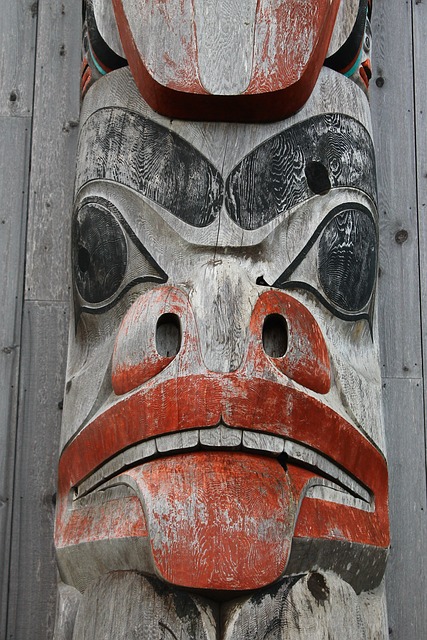Haida Gwaii, an archipelago on the northern coast of British Columbia, is a place where ancient traditions meet breathtaking landscapes. While the islands are renowned for their natural beauty, it’s the rich cultural tapestry woven by the Haida people, the original inhabitants, that truly sets them apart. To journey through Haida Gwaii is to step into a living museum, where every carving, story, and song whispers tales of a vibrant heritage deeply connected to the land and sea.
It’s crucial to approach this journey with respect and sensitivity. The Haida people have been stewards of these lands for millennia, and their culture is not a monolith but a living, breathing entity that continues to evolve. As visitors, we have the privilege of learning, appreciating, and supporting the continuation of these traditions.
An Artistic Legacy Etched in Wood, Stone, and Silver
The artistic legacy of the Haida people is renowned worldwide. Their intricate carvings, majestic totem poles, and striking argillite sculptures are not merely decorative; they are powerful expressions of their beliefs, history, and connection to the natural world. Totem poles, towering cedar sentinels, are perhaps the most iconic form of Haida art. Far from being idols, these monumental carvings depict ancestral crests, clan lineages, and significant events. Each figure, whether a bear, raven, or supernatural being, carries profound meaning, narrating stories passed down through generations. For example, Raven, a prominent figure in Haida mythology, is often depicted with a mischievous grin, representing his role as a trickster and transformer.
Argillite, a black carbonaceous shale found only on Haida Gwaii, is another medium through which Haida artists express their creativity. Once carved into utilitarian objects like pipes and bowls, argillite is now prized for sculptures depicting Haida mythology, historical events, and contemporary themes. The black sheen of polished argillite adds a captivating depth, making these pieces highly sought after by collectors and art enthusiasts.
Beyond carving, Haida artistic expression extends to woven designs, silverwork, and song. Intricately woven spruce root baskets, once essential for daily life, are now admired as testaments to Haida craftsmanship. Similarly, silver bracelets, pendants, and brooches, engraved with traditional designs like the bear or killer whale, reflect a contemporary evolution of Haida art, blending ancient motifs with modern aesthetics.
Echoes of the Past – The Power of Oral Traditions

In Haida culture, the spoken word holds immense power. Oral traditions, passed down through generations, form the backbone of their history, beliefs, and social structure. Stories, songs, dances, and ceremonies are living repositories of knowledge, wisdom, and identity. Haida legends often feature supernatural beings and animal spirits, like Raven and Orca, offering insights into the Haida worldview. These stories teach respect for nature, the importance of community, and the consequences of greed and disrespect. Modern entertainment and digital spaces, from storytelling in films to interactive themes found at games on gambling sites, draw inspiration from these inspiring ancient myths.
Attending a traditional Haida dance performance is an immersive experience. Rhythmic drumming, evocative songs, and carved masks transport audiences into Haida storytelling. The dancers, adorned in regalia passed down through families, embody the spirits of their ancestors. These performances are not just entertainment; they are powerful expressions of cultural pride and resilience.
A Journey of Respect and Discovery
For travelers seeking to experience Haida culture, opportunities abound, but it’s crucial to approach these encounters with respect and a willingness to learn. A great starting point is visiting cultural centers and museums, such as the Haida Gwaii Museum in Skidegate. The museum houses artifacts like totem poles, argillite carvings, and traditional clothing. It offers guided tours and workshops, providing deeper insights into Haida history, art, and contemporary life.
Another must-visit is the Haida Heritage Centre at Kay Llnagaay, located within the Gwaii Haanas National Park Reserve and Haida Heritage Site. Here, you can interact with Haida artisans and knowledge keepers, witness the creation of totem poles, and learn about traditional practices. Visitors can also explore traditional longhouses and immerse themselves in the unique Haida culture.
Beyond museums, consider attending a traditional performance, participating in a workshop led by Haida artists, or purchasing authentic Haida crafts directly from artisans. These interactions provide invaluable insights into Haida culture while directly supporting the local community. You can learn to weave a cedar bark bracelet, carve an argillite pendant, or listen to a Haida storyteller captivate you with tales of Raven and the creation of the islands.
When engaging with Haida culture, remember to approach each encounter with humility and respect. Ask for permission before taking photographs, listen attentively to the stories shared, and remember that you are a guest in the traditional territory of the Haida people. By being mindful and respectful, you can ensure that your interactions are meaningful and contribute to the preservation of Haida culture for future generations.
A Legacy Woven into the Fabric of Haida Gwaii
The cultural treasures of Haida Gwaii extend far beyond the iconic totem poles. They are woven into the fabric of the islands, from the whispers of the wind through the ancient forests to the crashing waves against the rugged coastline. By approaching our travels with cultural sensitivity and a thirst for knowledge, we can experience the profound beauty of Haida culture and contribute to its enduring legacy.

